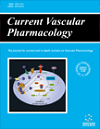- Home
- A-Z Publications
- Current Vascular Pharmacology
- Previous Issues
- Volume 19, Issue 6, 2021
Current Vascular Pharmacology - Volume 19, Issue 6, 2021
Volume 19, Issue 6, 2021
-
-
Exosomes and Exosomal microRNAs in Age-associated Stroke
More LessAuthors: Xiang Wang, Changmei H. Fu, Xiudeng Zhu, Jiehong Liu, Xinqin Gong, Qunwen Pan and Xiaotang MaAging has been considered to be the most important non-modifiable risk factor for stroke and death. Changes in circulation factors in the systemic environment, cellular senescence and artery hypertension during human ageing have been investigated. Exosomes are nanosize membrane vesicles that can regulate target cell functions via delivering their carried bioactive molecules (e.g. protein, mRNA, and microRNAs). In t Read More
-
-
-
Increased Fetal Cardiovascular Disease Risk: Potential Synergy Between Gestational Diabetes Mellitus and Maternal Hypercholesterolemia
More LessAuthors: Cristian Espinoza, Barbara Fuenzalida and Andrea LeivaCardiovascular diseases (CVD) remain a major cause of death worldwide. Evidence suggests that the risk for CVD can increase at the fetal stages due to maternal metabolic diseases, such as gestational diabetes mellitus (GDM) and maternal supraphysiological hypercholesterolemia (MSPH). GDM is a hyperglycemic, inflammatory, and insulin-resistant state that increases plasma levels of free fatty acids and triglycerides, impa Read More
-
-
-
By Discontinuing Beta-Blockers Before an Exercise Test, We may Precipitate a Rebound Phenomenon
More LessAuthors: Goran Koracevic, Sladjana Micic and Milovan StojanovicBackground: There is a need to analyse the current approach to beta-blocker (BB) use in relation to exercise-based stress tests. Objective: We compared various guidelines regarding recommending abrupt vs. gradual discontinuation of BB prior to exercise tests. We also analyse the shortcomings of the currently recommended approach and suggest a new approach to avoid BB rebound. Methods: A narrative review i Read More
-
-
-
Improved Lipid Target Level Attainment in Patients with Peripheral Artery Disease
More LessBackground: Patients with peripheral artery disease (PAD) fall under the category of a very high cardiovascular risk. Although consequent lipid-lowering therapy (LLT) is advised, only sparse data on attained target level in PAD exists. Objectives: We aimed to analyse contemporary guideline recommendations for LLT in symptomatic PAD patients. Methods: A monocentric, prospective, observational study involving 200 sympto Read More
-
-
-
Pro-inflammatory Mediators and Oxidative Stress: Therapeutic Markers for Recurrent Angina Pectoris after Coronary Artery Stenting in Elderly Patients
More LessAuthors: Xia Li, Dianxuan Guo, Hualan Zhou, Youdong Hu, Xiang Fang and Ying ChenBackground: Pro-inflammatory mediators and oxidative stress are related to the severity of angina pectoris in patients with coronary heart disease. Objective: We evaluated the effects of pro-inflammatory mediators and oxidative stress on recurrent angina pectoris after coronary artery stenting in elderly patients. Methods: We determined the expression levels of malondialdehyde (MDA), acrolein (ACR), tumour necrosis factor-α ( Read More
-
-
-
Outcomes of Anticoagulant Therapy with Low-Molecular-Weight Heparin (LMWH) and Warfarin for Thromboangiitis Obliterans (TAO)
More LessAuthors: Jiangping Gao, Liuhuan Huang and Jianli WangBackground: Thromboangiitis obliterans (TAO) is a chronic, non-atherosclerotic, progressive inflammatory vascular disease affecting the small- and medium-size arteries and veins of the extremities. Objective: To evaluate whether long-term anticoagulation with low-molecular-weight heparin (LMWH) and warfarin is beneficial for treating the inflammation and symptoms associated with TAO. Methods: Patients with TAO who un Read More
-
-
-
Association of PAF and its Metabolic Enzymes with GGT and the Fatty Liver Index in Healthy Volunteers
More LessBackground: Platelet-activating-factor (PAF) is a lipid inflammatory mediator implicated in liver disease. Its main biosynthetic enzymes are cytidine diphosphate (CDP)-choline: 1-alkyl-2-acetyl-sn-glycerol-cholinephosphotransferase (PAF-CPT) and acetyl-coenzyme A: lyso-PAF-acetyltransferases (Lyso-PAF-AT). At the same time, PAF acetylhydrolase (PAF-AH) and lipoprotein-associated phospholipase A2 (Lp-PLA2) degrade PAF. Obj Read More
-
Volumes & issues
-
Volume 23 (2025)
-
Volume 22 (2024)
-
Volume 21 (2023)
-
Volume 20 (2022)
-
Volume 19 (2021)
-
Volume 18 (2020)
-
Volume 17 (2019)
-
Volume 16 (2018)
-
Volume 15 (2017)
-
Volume 14 (2016)
-
Volume 13 (2015)
-
Volume 12 (2014)
-
Volume 11 (2013)
-
Volume 10 (2012)
-
Volume 9 (2011)
-
Volume 8 (2010)
-
Volume 7 (2009)
-
Volume 6 (2008)
-
Volume 5 (2007)
-
Volume 4 (2006)
-
Volume 3 (2005)
-
Volume 2 (2004)
-
Volume 1 (2003)
Most Read This Month
Article
content/journals/cvp
Journal
10
5
false
en


